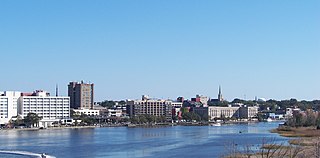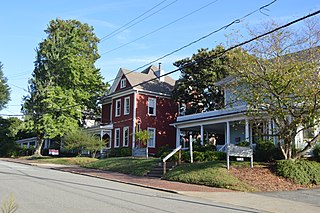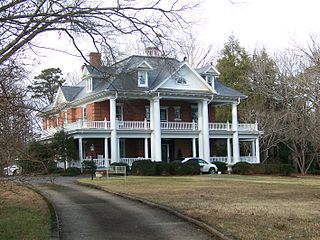
Wilmington is a port city in New Hanover County, North Carolina, United States. With a population of 115,451 as of the 2020 census, it is the eighth-most populous city in the state. The county seat of New Hanover County, it is the principal city of the Wilmington metropolitan area, which includes New Hanover, Brunswick, and Pender counties. As of 2023, the region had an estimated population of 467,337.

College Hill is a neighborhood in the west central section of the United States city of Greensboro, North Carolina. College Hill was Greensboro's first neighborhood.

The High Hills of Santee, sometimes known as the High Hills of the Santee, is a long, narrow hilly region in the western part of Sumter County, South Carolina. It has been called "one of the state's most famous areas". The High Hills of Santee region lies north of the Santee River and east of the Wateree River, one of the two rivers that join to form the Santee. It extends north almost to the Kershaw county line and northeasterly to include the former summer resort town of Bradford Springs. Since 1902 the town has been included in Lee County.
Alston-DeGraffenried Plantation or Alston-DeGraffenried House is a historic property located in Chatham County, North Carolina, near Pittsboro, North Carolina. It includes a plantation house built through the forced labor of at least 11 enslaved people between about 1810 and 1825, and its surrounding agricultural fields. The property was first listed on the National Register of Historic Places in 1974 and the listed area was increased in 1993. The house and the surrounding land are identified as a national historic district.

The Quaker Hill Historic District is a national historic district located at Wilmington, New Castle County, Delaware. It encompasses 151 contributing buildings in a residential neighborhood west of the central business district of Wilmington. The district includes 19th-century residential structures of all classes, along with several 19th-and 20th-century commercial structures. The predominant structures are three-story rowhouse dwellings in a variety of popular styles including Second Empire, Italianate, and Gothic Revival. Notable non-residential buildings include the Quaker Meetinghouse and Cemetery, St. Peter's Cathedral and Rectory (1816), Union Methodist Church, and New Mount Bethel Baptist Church

Claremont High School Historic District is a national historic district located at Hickory, Catawba County, North Carolina. The district encompasses 172 contributing buildings and 3 contributing structures in a predominantly residential section of Hickory. Most of the dwellings date from the late 19th through mid-20th century and include notable examples of Queen Anne, Colonial Revival, Tudor Revival, and Bungalow / American Craftsman style architecture. The Claremont High School was completed in 1925, and is a three-story, H-shaped, Neoclassical style school. The school was rehabilitated in 1986 as an arts and science center. Other notable buildings include Maple Grove, Shuler-Harper House (1887), Harvey E. McComb House (1889), (former) Corinth Reformed Church Parsonage (1895), Shuford L. Whitener House, Judge W. B. Councill House (1902), George W. Hall House, Carolina Park, Josephine Lyerly House, John L. Riddle House (1918), Marshall R. Wagner House (1938), David M. McComb Jr. House (1939), Arthur H. Burgess House (1940), and R. L. Noblin House (1950).
Long Valley Farm is a historic farm and national historic district located in Carvers Creek State Park near Spring Lake in Cumberland County and Harnett County, North Carolina. It encompasses 24 contributing buildings and 5 contributing structures on a winter agricultural estate. The main house is known as the Long Valley Farm Seat, or James Stillman Rockefeller Residence, and was built in 1937–1938. It is a two-story, five-bay, Colonial Revival style frame dwelling with one-story wings. Other notable contributing resources are the Mill Pavilion, Mill House and Gates, Pack House, Forge, Great Barn, Overseer's House, Tobacco Barns, Worker's Houses, Springhouse, and Water Tower. Noted financier James Stillman Rockefeller become the full owner of Long Valley Farm in January 1937.

Holly Avenue Historic District is a national historic district located at Winston-Salem, Forsyth County, North Carolina. The district encompasses 115 contributing buildings and 1 contributing site in a predominantly residential section of Winston-Salem. The buildings date between about 1885 and 1952, and include single family dwellings and apartment building. The include examples of late-19th and early-20th popular architectural styles including the Queen Anne and Italianate style. Notable buildings include the Henry Case House, James Jessup House, Henry Foltz bam (1906), Calvary Moravian Church (1923), T. R. Brann's store, and Green Front Grocery.

York-Chester Historic District is a national historic district located at Gastonia, Gaston County, North Carolina, United States. It encompasses 649 contributing buildings, 2 contributing sites, and 1 contributing structure in a predominantly residential section of Gastonia. The dwellings were built between about 1856 and 1955, and include notable examples of Queen Anne and Bungalow / American Craftsman architecture. Located in the district are the separately listed former Gastonia High School. Other notable contributing resources include the Beal-Ragan Garden, Oakwood Cemetery, Caroline Hanna House, Spurrier Apartment building, Edgewood Apartments, the Joseph W. Lineberger House and Devant J. and June S. Purvis House (1951).
Camp Arrowhead, also known as Camp Glen Arden after 1972, is a historic summer camp and national historic district located near Tuxedo, Henderson County, North Carolina. It was established in 1919 by the Green River Manufacturing Company as a recreational facility, and became a boy's summer camp in 1937. The district encompasses 18 contributing buildings, 1 contributing site, and 5 contributing structures. Notable Rustic Revival style contributing buildings include the Recreation Hall/Gymnasium ; the group of log cabins dating from the original use of the camp by the Green River Manufacturing Company (1919); Ramshackle Cabin (1937); the Dining Hall/Kitchen ; Mansion Cabin ; and the Horse Barn (1953).

Academy Hill Historic District is a national historic district located at Statesville, Iredell County, North Carolina. It encompasses 40 contributing buildings in a mixed-use neighborhood of Statesville. The district includes notable examples of Late Victorian architecture including primarily brick educational and industrial buildings and one and two-story frame dwellings. They were mainly built between 1885 and 1930. Notable buildings include the former Statesville Male Academy (1874), Statesville Graded School (1892), J. C. Steele & Sons Brick Machinery Plant, Ash Tobacco Factory, O. W. Slane Glass Company, J. C. Steele House (1880s), C. M. Steele House (1901), H. Oscar Steele House, and William E. Webb House.

Tull–Worth–Holland Farm is a historic farm and national historic district located near Kinston, Lenoir County, North Carolina. It encompasses 14 contributing buildings and 1 contributing site. The district includes a significant cross section of domestic and agricultural buildings constructed between 1825 and 1942. The farmhouse was built about 1825, and is a two-story, Federal style frame dwelling. It has a gable roof, exterior end chimneys, and hall-and-parlor plan. Other contributing resources are the Cook's House, privy / chicken house, Delco house, playhouse, barn, stable, cotton gin, five tobacco barns, and a tenant house.
Spring Hope Historic District is a national historic district located at Spring Hope, Nash County, North Carolina. It encompasses 159 contributing buildings and 1 contributing structure in the small railroad town of Spring Hope. The buildings primarily date to the 19th and early 20th century, and include notable examples of Late Victorian and Bungalow / American Craftsman style architecture. Located in the district is the separately listed Dr. Hassell Brantley House. Other notable buildings include former Wilmington and Weldon railroad station, Bluford-Brantley House, Sykes Seed Store, Spivey's General Merchandise, Citizens Bank (1908), A. F. May gasoline station (1923), Hill's Auto Service (1933-1934), Spring Hope Cotton Seed Oil Company, Joseph J. Spivey House, Cone-Brantley House (1887), Richardson-Chamblee House (1901), and Morgan-Vester House (1923).

Carolina Place Historic District is a national historic district located at Wilmington, New Hanover County, North Carolina. The district encompasses 337 contributing buildings in a predominantly residential section of Wilmington. The district developed as Wilmington's first planned streetcar suburb between about 1906 and 1941 and includes notable examples of Queen Anne, Classical Revival, Colonial Revival, and Bungalow / American Craftsman style architecture.

Carolina Heights Historic District is a national historic district located at Wilmington, New Hanover County, North Carolina. The district encompasses 421 contributing buildings, 1 contributing site, and 1 contributing object in a predominantly residential section of Wilmington. The district developed as planned suburban areas between about 1908 and 1950 and includes notable examples of Queen Anne, Classical Revival, Colonial Revival, and Bungalow / American Craftsman style architecture. Notable buildings include the New Hanover High School (1922), the Trinity Methodist Episcopal Church (1921), St. Paul's Episcopal Church (1927/1956-1958), First Church of Christ, Scientist (1928), Sinclair Service Station, and Yopp Funeral Home (1936).

The Wilmington Historic District is a national historic district located at Wilmington, New Hanover County, North Carolina. The district encompasses 875 contributing buildings 38 contributing sites, and 3 contributing structures in the historic core and surrounding residential sections of Wilmington. The district developed after Wilmington was laid out in 1737, and includes notable examples of Queen Anne and Bungalow/American Craftsman style architecture. Located in the district are the separately listed City Hall/Thalian Hall and Alton Lennon Federal Building and Courthouse. Other notable buildings include:

Brookwood Historic District is a national historic district located at Wilmington, New Hanover County, North Carolina. The district encompasses 166 contributing buildings, 1 contributing site, 1 contributing structure, and 1 contributing object in a predominantly residential section of Wilmington. The district developed as planned suburban areas between about 1920 and 1964 and includes notable examples of Colonial Revival, and Bungalow / American Craftsman style architecture. Notable contributing resources include Brookwood Park, the Church of Jesus Christ of Latter Day Saints, Robert F. Rankin House, and Thomas E. Moody House.

Chapel Hill Historic District is a national historic district located at Chapel Hill, Orange County, North Carolina. The district encompasses 46 contributing buildings, 2 contributing structures, and 2 contributing objects on the central campus of the University of North Carolina at Chapel Hill and surrounding residential sections of Chapel Hill. The district's buildings date from 1793 to the early-20th century and include notable examples of Classical Revival and Jacobean Revival architecture. Located in the district and separately listed are the Chapel of the Cross, Old East, building and Playmakers Theatre. Other notable contributing resources are the Davie Poplar, Old West (1822), South Building (1798), the Old Well, Person Hall (1797), Gerrard Hall (1822), New East, New West, the Joseph Caldwell Monument (1858), the Y.M.C.A. Building, Battle-Vance-Pettigre11 Dormitory (1913), Horace Williams House (1854), the Phillips Law Office, the Phillips House (1856), the Old Methodist Church (1853), Senlac, Hippol Castle (1920s), and Battle Park.

Washburn Historic District is a national historic district located near Bostic, Rutherford County, North Carolina. It encompasses 17 contributing buildings and 1 contributing structure in the crossroads community of Washburn. It developed after 1915, and includes notable examples of Classical Revival style architecture. The principal historic buildings in the district are the Edgar Nollie Washburn House, two rental dwellings, a barn, the Washburn store, the Washburn Funeral Home, and Washburn-Davis House.

Mordecai Place Historic District is a historic neighborhood and national historic district located at Raleigh, North Carolina. The district encompasses 182 contributing buildings and 1 contributing object in the most architecturally varied of Raleigh's early-20th century suburbs for the white middle-class. Mordecai Place was listed on the National Register of Historic Places in February 1998, with a boundary increase in 2000.



















